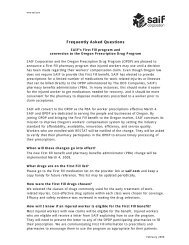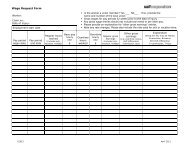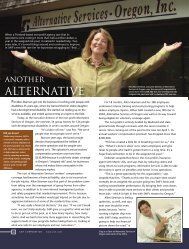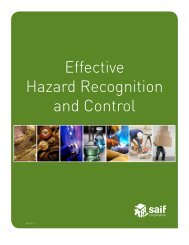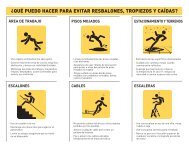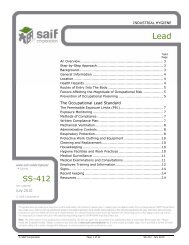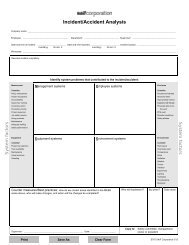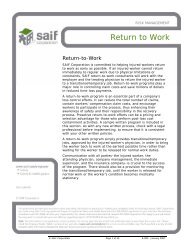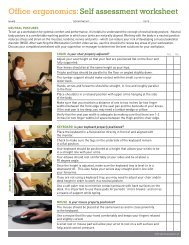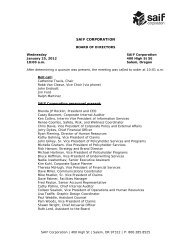Noise and Hearing Conservation - SAIF Corporation
Noise and Hearing Conservation - SAIF Corporation
Noise and Hearing Conservation - SAIF Corporation
You also want an ePaper? Increase the reach of your titles
YUMPU automatically turns print PDFs into web optimized ePapers that Google loves.
RISK MANAGEMENT<br />
<strong>Noise</strong> <strong>and</strong> <strong>Hearing</strong> <strong>Conservation</strong><br />
Resources <strong>and</strong> information for developing<br />
Patient h<strong>and</strong>ling programs in health care<br />
Employers with workplaces that have excessive levels of<br />
noise need to implement a comprehensive noise control<br />
program to help prevent their workers from suffering noiseinduced<br />
hearing losses <strong>and</strong> to reduce workers’<br />
compensation claims.<br />
To assist you in developing a <strong>Noise</strong> <strong>and</strong> <strong>Hearing</strong><br />
<strong>Conservation</strong> Program, <strong>SAIF</strong> <strong>Corporation</strong>’s Industrial<br />
Hygiene Section has produced this packet of information.<br />
You’ll also find a variety of other valuable safety <strong>and</strong><br />
health information at our web site saif.com/employer<br />
—specifically designed to help your business prevent<br />
injuries <strong>and</strong> control costs.<br />
Please note that the information in this h<strong>and</strong>out is<br />
concerned with continuous or steady-state noise, the most<br />
common cause of noise-induced hearing loss in workers. If<br />
your workplace has exposure to “impact” noise when noise<br />
impulses occur at peak level in intervals, please contact the<br />
Industrial Hygiene Section toll-free at 800.285.8525 for<br />
additional information.<br />
July 2010<br />
S-822
Risk Management <strong>Noise</strong> <strong>and</strong> <strong>Hearing</strong> <strong>Conservation</strong><br />
www.saif.com<br />
The information in this packet includes:<br />
• Overview on noise <strong>and</strong> hearing conservation<br />
• Oregon Administrative Rules (437, Division 2/G) summary on<br />
noise <strong>and</strong> hearing conservation<br />
• Recording hearing loss cases on the OSHA 300 log<br />
• Training program for employees exposed to excessive noise levels<br />
• Frequently asked questions<br />
• Resource links<br />
<strong>Noise</strong> <strong>and</strong> <strong>Hearing</strong> <strong>Conservation</strong> Overview<br />
Whether noise produces a permanent loss of hearing in exposed<br />
workers depends on several factors:<br />
• Loudness<br />
• Exposure time<br />
• Individual susceptibility to noise-induced hearing loss<br />
• Presence of engineering controls<br />
The more intense or louder the noise, the more likely it will contribute to<br />
hearing loss. The longer a worker is exposed to a particular noise, the<br />
greater the chance injury will occur to the auditory system.<br />
The Oregon Occupational Safety <strong>and</strong> Health Division (OR-OSHA)<br />
requires that employees have a workplace below the current 8-hour<br />
time-weighted average (8-hour TWA) of 90 decibels A scale (dBA). A<br />
hearing conservation program is required for employees exposed to an<br />
8-hour TWA at or above 85 dBA. If workplace exposures reach or exceed<br />
an 8-hour TWA of 90, an employer must use one of the following<br />
methods of control to limit employee exposure to noise.<br />
1. Engineering Controls —<br />
Reduce noise at the source by enclosing noise source, placing<br />
employees in sound-proof booths or installing less noisy<br />
machinery.<br />
2. Administrative Controls —<br />
Rotate employees from noisy areas to quieter areas so that the<br />
exposure time to high intensity noise is reduced.<br />
3. Personal Protective Equipment —<br />
Require the use of appropriately selected hearing protection to<br />
reduce the amount of noise entering the employee’s ear.<br />
© <strong>SAIF</strong> <strong>Corporation</strong> Page 2 of 11 S-822 July 2010
Risk Management <strong>Noise</strong> <strong>and</strong> <strong>Hearing</strong> <strong>Conservation</strong><br />
www.saif.com<br />
Oregon Administrative Rules Summary<br />
I. <strong>Noise</strong> Exposure<br />
The permissible noise exposure section requires engineering or<br />
administrative controls to reduce exposures exceeding 90 dBA for<br />
8 hours; 95 dBA for 4 hours; 100 dBA for 2 hours. The impulse or<br />
impact noise st<strong>and</strong>ard allows no sound level exceeding 140 dBA<br />
peak sound pressure level. Only noise levels at or above 90 dBA<br />
must be considered for controls.<br />
II. <strong>Hearing</strong> <strong>Conservation</strong><br />
An employer is required to institute a <strong>Hearing</strong> <strong>Conservation</strong> Program<br />
whenever employee noise exposures equal or exceed an 8-hour TWA of<br />
85 dBA, or a noise dose of 50 percent. This is known as the “action level.”<br />
The employer must monitor employee’s exposures to determine<br />
whether they exceed the 8-hour TWA of 85 dBA. The requirement for<br />
noise dosimetry includes all “continuous, intermittent <strong>and</strong> impulsive<br />
sound levels from 80 dBA to 130 dBA.” The audiometric testing<br />
program requires that audiometric testing be provided to all employees<br />
whose exposure exceeds the 85 dBA TWA “action level.” The baseline<br />
audiogram must be provided within 6 months of placement in a job<br />
with high noise exposures. This audiogram should be preceded by at<br />
least 14 hours of quiet. The annual audiogram shall be obtained at any<br />
time during the work shift.<br />
If the annual audiogram reveals a change in hearing threshold<br />
relative to the baseline audiogram of an average of 10 dBA or more<br />
at 2000, 3000 <strong>and</strong> 4000 Hz in either ear, the employee must be<br />
notified in writing within 21 days <strong>and</strong> additional follow-up is required.<br />
This change is called a “st<strong>and</strong>ard threshold shift.”<br />
The area in which audiometric exams are conducted must be tested to<br />
show that background noise levels are low enough. The audiometer must<br />
be checked each day on a person whose hearing is stable. This is the<br />
daily, biological calibration. In addition, the audiometer must be<br />
acoustically calibrated at least annually.<br />
<strong>Hearing</strong> protectors must be made available to all employees exposed<br />
above the 85 dBA TWA. The employer must enforce their use by<br />
employees who are exposed above 90 dBA (at 85 dBA or above for<br />
employees who experience a st<strong>and</strong>ard threshold shift). For those<br />
employees who do have a st<strong>and</strong>ard threshold shift, the hearing protector<br />
must also attenuate the noise level so that the calculated exposure of the<br />
inner ear is 85 dBA or below. For all other employees, the attenuation<br />
must only reduce the exposure to 90 dBA as an 8 hour TWA.<br />
© <strong>SAIF</strong> <strong>Corporation</strong> Page 3 of 11 S-822 July 2010
Risk Management <strong>Noise</strong> <strong>and</strong> <strong>Hearing</strong> <strong>Conservation</strong><br />
www.saif.com<br />
The attenuation factor or <strong>Noise</strong> Reduction Rating (NRR) is found on<br />
each package of protectors. To calculate the dBA attenuation, subtract<br />
7 from the NRR, <strong>and</strong> then subtract the remaining NRR from the noise<br />
level. Thus, if the noise level is 100 dBA, a NRR of 25 would reduce the<br />
exposure to 82 dBA.<br />
The employer must provide a training program <strong>and</strong> repeat it annually.<br />
The employer must keep records of exposure measurements,<br />
audiograms, audiometer calibration <strong>and</strong> audiometric test area<br />
background noise.<br />
8-hour average exposure below 85 dBA<br />
(daily noise dose less than 50 percent)<br />
1. No requirements.<br />
2. Recommend maintaining any records, sound level surveys or<br />
audiometric test results which may have been conducted.<br />
8-hour average exposure of 85 to 90 dBA<br />
(daily noise dose 50 to 100 percent)<br />
1. Complete noise evaluation (records to be kept for two years).<br />
2. Audiometric examinations annually<br />
a. OR-OSHA requires records to be kept for length of<br />
employment. <strong>SAIF</strong> recommends maintaining these<br />
records indefinitely.<br />
b. Baseline test within 6 months of hire. <strong>SAIF</strong> recommends<br />
testing at hire date.<br />
3. Audiograms indicating hearing loss must be reviewed by a qualified<br />
specialist.<br />
4. Referral of employees with hearing loss to a qualified specialist at no<br />
cost to employee.<br />
5. <strong>Hearing</strong> protection devices made available for all employees exposed<br />
above 85 dBA 8-hour average sound level.<br />
6. <strong>Hearing</strong> protection use is m<strong>and</strong>atory for employees with a hearing<br />
loss. (<strong>Hearing</strong> protectors must have a <strong>Noise</strong> Reduction Rating (NRR)<br />
sufficient to reduce the 8-hour average noise exposure to 85 dBA or<br />
below.) If no hearing loss is observed, hearing protection use is<br />
optional, however, <strong>SAIF</strong> <strong>Corporation</strong> highly recommends the use of<br />
hearing protectors for exposures between 85 <strong>and</strong> 90 dBA.<br />
7. Employer must furnish a choice of two or more types of hearing<br />
protectors.<br />
© <strong>SAIF</strong> <strong>Corporation</strong> Page 4 of 11 S-822 July 2010
Risk Management <strong>Noise</strong> <strong>and</strong> <strong>Hearing</strong> <strong>Conservation</strong><br />
www.saif.com<br />
8. Employees must be trained in proper use of hearing protectors,<br />
purpose of audiometric testing, <strong>and</strong> effect of noise on hearing.<br />
9. <strong>Noise</strong> code <strong>and</strong> training materials must be made available to<br />
employees.<br />
Average 8-hour exposure above 90 dBA<br />
(daily noise dose greater than 100 percent)<br />
1. All of the above requirements, plus the following:<br />
2. Engineering or administrative controls to reduce noise to 90 dBA or<br />
below, if technically <strong>and</strong> economically “feasible.”<br />
3. <strong>Hearing</strong> protection use m<strong>and</strong>atory for all employees exposed to 8-<br />
hour average sound level of 90 dBA or greater.<br />
4. <strong>Hearing</strong> protectors must have a NRR sufficient to reduce the average<br />
noise exposure to 90 dBA or below.<br />
Recordkeeping<br />
If you are required to keep the OSHA 300 Log (if you are not sure please<br />
refer to OSHA’s publication “OSHA Forms for Recording Work-Related<br />
Injuries <strong>and</strong> Illnesses” at http://www.cbs.state.or.us/external/osha/<br />
pdf/pubs/3353_osha300.pdf) there has been a change in the criteria for<br />
reporting occupational hearing loss. The work related hearing loss must<br />
now be recorded on the log when: (1) An annual audiogram reveals a<br />
st<strong>and</strong>ard threshold shift in either or both ears; <strong>and</strong> (2) the hearing level<br />
in the same ear is 25 dB above audiometric zero.<br />
A st<strong>and</strong>ard threshold shift is defined as an average of 10 dB or more at<br />
2000, 3000, <strong>and</strong> 4000 Hertz in either ear. Prior to January 1, 2003, the<br />
requirement calls for a log entry when the work related shift was an<br />
average of 25dB or more. Ensure that your audiometric service provider<br />
is notifying you which cases are recordable based on the revised<br />
recordkeeping criteria.<br />
The reporting requirements have allowances for age of the employee,<br />
retesting within 30 days of the first test, <strong>and</strong> input by a licensed health<br />
care professional. These allowances, along with the full requirements,<br />
are found in OAR 437-001-0700 (11), Recordkeeping <strong>and</strong> Reporting.<br />
© <strong>SAIF</strong> <strong>Corporation</strong> Page 5 of 11 S-822 July 2010
Risk Management <strong>Noise</strong> <strong>and</strong> <strong>Hearing</strong> <strong>Conservation</strong><br />
www.saif.com<br />
© <strong>SAIF</strong> <strong>Corporation</strong> Page 6 of 11 S-822 July 2010
Risk Management <strong>Noise</strong> <strong>and</strong> <strong>Hearing</strong> <strong>Conservation</strong><br />
www.saif.com<br />
Frequently Asked Questions<br />
Why does <strong>SAIF</strong> <strong>Corporation</strong> recommend wearing hearing protection for all<br />
employees exposed to between 85 <strong>and</strong> 90 dBA when OR-OSHA requires it<br />
only for those with threshold shifts<br />
The OR-OSHA codes for hearing protection are regulatory requirements.<br />
Employees may still experience hearing loss with long-term exposure<br />
between 85 <strong>and</strong> 90 dBA.<br />
The code requires baseline audiograms within 6 months of an<br />
employee’s first exposure to noise above 85 dBA. Some employers,<br />
however, require audiograms as part of the hiring process. Why<br />
One reason is to document if hearing loss has occurred prior to<br />
employment with your firm. Oregon employers must be able to show<br />
that the “last injurious exposure” did not occur with them or they may<br />
be responsible for hearing loss claims. If they wait 6 months to conduct<br />
an audiogram then it may be difficult to know if the employee’s hearing<br />
loss arose, or if existing loss worsened, with the current employer<br />
rather than prior to being hired.<br />
We provide annual audiograms after the baseline audiogram at<br />
time of hire. Should we be monitoring noise levels on an annual<br />
basis too<br />
Remonitoring should be conducted when there are significant changes<br />
in production, process, equipment, or controls that increase or decrease<br />
noise levels. This may be more or less often than every twelve months.<br />
Monitoring data can be used on a representative basis to determine which<br />
employees are to be included in your hearing conservation program.<br />
Our company must implement a hearing conservation program.<br />
Does this mean we have to wear hearing protection from now on<br />
Not necessarily. <strong>Hearing</strong> protection should be the last resort of control<br />
measures. You should first look for ways to reduce noise through<br />
engineering or administrative controls. Often a relatively simple change<br />
can reduce noise by a significant amount. See page 2, for examples of<br />
each control.<br />
We have access to a sound level meter. Can we rely on this instrument<br />
to determine if a hearing conservation program is required<br />
Following procedures in Appendix A of 1910.95 – you could rely on a<br />
sound level meter to determine if a program is required.<br />
© <strong>SAIF</strong> <strong>Corporation</strong> Page 7 of 11 S-822 July 2010
Risk Management <strong>Noise</strong> <strong>and</strong> <strong>Hearing</strong> <strong>Conservation</strong><br />
www.saif.com<br />
However, where there is high worker mobility, significant variations in<br />
sound level, or a significant component of impulse noise, making area<br />
monitoring inappropriate, representative personal sampling (noise<br />
dosimetry) should be used.<br />
I provide hearing protection for those required to wear it but it is<br />
seldom worn. What is the employer’s responsibility in this regard<br />
Providing protection is not enough. Employers are required to ensure<br />
that hearing protection is worn when required. If wearing protection is<br />
a problem management should find out why. Several areas to explore<br />
are the selection, fitting <strong>and</strong> proper use of equipment. The employer<br />
should manage the wearing of hearing protection like every other<br />
aspect of their business.<br />
Training Program<br />
Our sense of hearing is often taken for granted. It is only when we lose<br />
our hearing, that we realize its importance to the quality of our lives.<br />
Unfortunately, much permanent damage can be done to our sense of<br />
hearing before we are aware of it.<br />
How we hear<br />
Sound waves move through the<br />
outer ear <strong>and</strong> set up vibrations in<br />
the middle ear. The vibrations are<br />
then transferred to the inner ear.<br />
The wave motion in the inner ear is<br />
sensed by cells which transmit<br />
neural messages to the brain.<br />
Effects of noise on hearing<br />
Prolonged exposure to excessive<br />
noise levels can cause a noiseinduced<br />
hearing loss.<br />
When you are exposed to excessive<br />
noise levels, the first effect usually<br />
is a temporary hearing loss. You<br />
may have difficulty in conversation<br />
or the ears may feel “plugged” <strong>and</strong> “ring.” Over a period of time, an<br />
individual who experiences repeated temporary hearing loss will have<br />
gradual, permanent, irreversible hearing loss.<br />
© <strong>SAIF</strong> <strong>Corporation</strong> Page 8 of 11 S-822 July 2010
Risk Management <strong>Noise</strong> <strong>and</strong> <strong>Hearing</strong> <strong>Conservation</strong><br />
www.saif.com<br />
<strong>Noise</strong>-induced hearing loss involves damage to the receptor cells in the<br />
inner ear <strong>and</strong> is classified as sensori-neural impairment. A noise-induced<br />
hearing loss typically begins with a drop in hearing level at the higher<br />
frequencies of sound. As the hearing loss increases, it includes the lower<br />
sound frequencies that include speech. Early noise-induced hearing loss<br />
normally is not detected by an individual, since it occurs above the speech<br />
range. By the time an individual is aware of a hearing loss, the amount of<br />
loss may be significant.<br />
Audiometric testing<br />
Audiometric testing is a means of determining your hearing ability.<br />
“Normal” hearing includes the median hearing level of a large group of<br />
American adults between 18 <strong>and</strong> 25 years of age, having no known history<br />
of ear disease <strong>and</strong> no appreciable high-level noise exposure. The accepted<br />
normal range of hearing is between 0 <strong>and</strong> 25 decibels.<br />
The audiometric test consists of exposing each ear separately to sound at<br />
six different frequencies. The audiometric test will indicate the amount of<br />
hearing loss, if any, of an individual. The higher the decibel reading, the<br />
greater the hearing loss. As an individual ages, there is a natural hearing<br />
loss which takes place. This is called presbycusis. A cold, an ear infection,<br />
or recent high noise exposure can cause a temporary hearing loss which<br />
would produce poor test results.<br />
You can help prevent noise-induced hearing loss by wearing personal<br />
protective equipment. There are three types of ear protectors: a muff<br />
which covers the entire ear, a plug which is inserted into the ear canal,<br />
<strong>and</strong> a “stopper,” or caps which cover the outer end of the ear canal.<br />
All three types of hearing protectors are designed to reduce the<br />
amount of noise reaching the inner ear.<br />
Type Advantages Disadvantages<br />
____________________________________________________________<br />
Muffs Easy to fit in place <strong>and</strong> Cause pressure on the head<br />
take on <strong>and</strong> off<br />
Easy for management<br />
to monitor their use<br />
May not have a good seal<br />
with glasses or long hair<br />
Do not irritate the ear canal Are hot to wear in the summer<br />
____________________________________________________________<br />
© <strong>SAIF</strong> <strong>Corporation</strong> Page 9 of 11 S-822 July 2010
Risk Management <strong>Noise</strong> <strong>and</strong> <strong>Hearing</strong> <strong>Conservation</strong><br />
www.saif.com<br />
Inserts Inexpensive Difficulty in fitting<br />
(must fit tightly to be effective)<br />
More readily accepted<br />
by workers<br />
Tend to loosen with jaw movement<br />
Can irritate the ear canal<br />
Selection of ear protectors<br />
The reduction of noise by using hearing protectors is called attenuation. This<br />
is expressed in decibels. The manufacturer of each hearing protector will<br />
indicate the level of attenuation for each type of protector. It will be listed on<br />
the package as the <strong>Noise</strong> Reduction Rating (NRR).<br />
Ear protector selections should be based employee convenience, comfort,<br />
<strong>and</strong> proper degree of attenuation. Under attenuating would lead to excessive<br />
noise exposure. Over attenuating in moderate noise levels can lead to a<br />
feeling of isolation <strong>and</strong>, consequently, poor acceptance of the protectors.<br />
Fitting<br />
Earplugs must fit tightly to provide a good seal. The earplug is inserted by<br />
grasping the ear with the opposite h<strong>and</strong>, pulling it up <strong>and</strong> out to open the<br />
ear canal <strong>and</strong> then inserting the plug with the other h<strong>and</strong>.<br />
Muffs will normally fit all people without any difficulty. Eyeglasses may<br />
interfere with the proper fitting of the muff. Muffs that attach directly to<br />
hard hats are also available.<br />
Ear stoppers are usually easy to position. The headb<strong>and</strong> can be worn on<br />
top of or behind the head, or under the chin.<br />
When hearing protectors are initially worn, it may take a short time for the<br />
employee to adjust to the new level of sounds. The same sounds are<br />
heard, but at a lower intensity.<br />
Care <strong>and</strong> use of ear protectors<br />
Ear protectors must be maintained in sanitary condition. It is important<br />
that earplugs be clean when inserted into the ears. If plugs are dirty when<br />
inserted, they may cause irritation which could lead to infection of the ear<br />
canal. The same applies to stoppers.<br />
Earplugs, when not in use, should be stored in some type of container<br />
which can be closed to seal out dust or dirt. Earplugs should be replaced<br />
when they no longer can be cleaned or when they lose their pliability.<br />
© <strong>SAIF</strong> <strong>Corporation</strong> Page 10 of 11 S-822 July 2010
Risk Management <strong>Noise</strong> <strong>and</strong> <strong>Hearing</strong> <strong>Conservation</strong><br />
www.saif.com<br />
Ear muffs have a replaceable seal which should be kept clean. The seal<br />
should be replaced whenever it becomes stiff or cracked.<br />
Resource Links<br />
Federal OSHA<br />
<strong>Noise</strong> <strong>and</strong> <strong>Hearing</strong> <strong>Conservation</strong><br />
www.osha.gov/SLTC/noisehearingconservation/index.html<br />
Oregon OSHA<br />
<strong>Noise</strong><br />
www.orosha.org/subjects/noise.html<br />
CDC/NIOSH<br />
<strong>Noise</strong><br />
www.cdc.gov/nceh/hsb/noise/<br />
Criteria for a Recommended St<strong>and</strong>ard:<br />
Occupational <strong>Noise</strong> Exposure<br />
www.cdc.gov/niosh/docs/98-126<br />
© <strong>SAIF</strong> <strong>Corporation</strong> Page 11 of 11 S-822 July 2010



